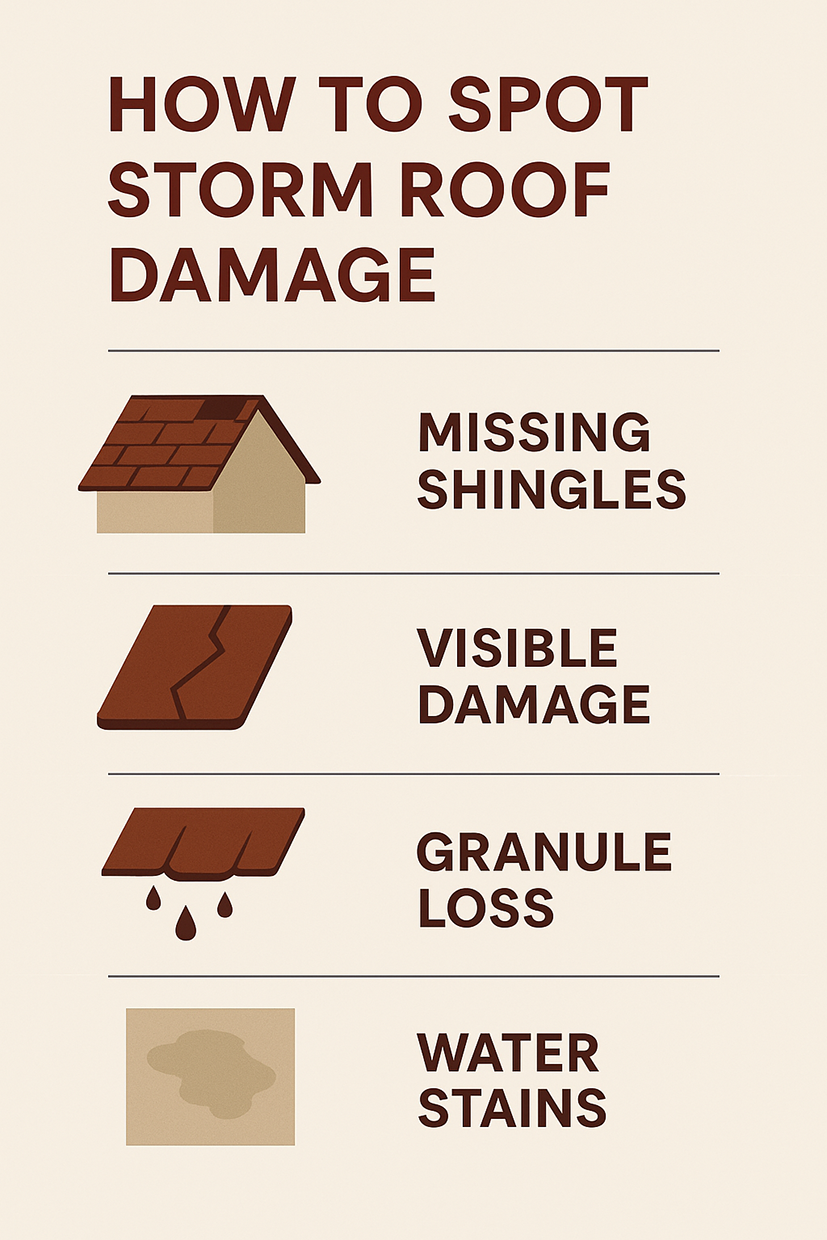Storms have a way of leaving a neighborhood looking the same on the surface—calm skies, sunlight breaking through, and streets returning to normal. But roofs often tell a different story. The trouble is, most storm roof damage isn’t obvious at first glance. Minor issues hide under shingles, around vents, and inside the attic, quietly getting worse after the weather clears.
We will walk Sacramento County homeowners through the signs of storm roof damage, how to spot problems early, and when to bring in a professional. The goal is simple: help you protect your home before small concerns turn into expensive repairs.
Key Takeaways
- Understanding Storm Roof Damage: Storm roof damage includes visible issues like missing shingles, but also slow-developing problems from wind, hail, debris, and heavy rain which may not be immediately obvious.
- Exterior Signs of Roof Damage: Check from the ground for missing or cracked shingles, granules in gutters, dented metal surfaces, and damaged flashing or gutters, as these indicate storm-related issues.
- Interior Signs of Storm Damage: Look inside your home for water stains, bubbling paint, attic mold, or sagging drywall, which can signal roof leaks even if the damage isn’t visible outside.
- Progression of Damage Over Time: Small storm damage, such as lifted shingles or bent flashing, can worsen gradually, leading to leaks, mold, wood rot, and a reduced roof lifespan if not addressed early.
- When to Call a Professional: Hire a roofing expert for a safe and thorough inspection after a storm, especially if you notice missing shingles, dents, or water inside your home, to prevent further damage.
What “Storm Roof Damage” Means
When people think of roof damage after a storm, they picture missing shingles or a visible hole from a fallen branch. And yes—those are clear warning signs. But storms put a lot of stress on a roof, and many problems develop slowly.
Storm roof damage can come from:
- Wind that lifts shingles and exposes the underlayment
- Hail that dents shingles or knocks off protective granules
- Heavy rain that exploits tiny gaps around flashing or vents
- Debris impact that cracks shingles or damages gutters
- Falling branches that break or weaken structural areas
Some of this damage is visible from the ground. Much of it is not. That’s why checking your roof after a storm—carefully and safely—is essential.
Exterior Signs of Storm Roof Damage
You never need to climb onto your roof to spot potential issues. Everything below can be seen from the ground or by using a phone camera on zoom.
1. Missing, Cracked, or Curled Shingles
Strong winds can lift shingles or pull them completely off. Even one missing shingle exposes the roof deck beneath. According to GAF’s homeowner guide , shingle edges often loosen first, so look closely at corners and ridges.
2. Granules Collecting in Gutters or Around Downspouts
Granules protect shingles from UV damage. After hail or high winds, they can wash off in large amounts. If you see what looks like coarse sand near your home’s foundation, it’s a sign your shingles took a hit.
3. Hail Dents on Shingles, Vents, or Metal Surfaces
Hail damage isn’t always dramatic. Owens Corning’s storm checklist explains that even small hail can bruise a shingle, increasing the likelihood of failure months later.
4. Damaged or Bent Flashing
Flashing is often the first line of defense around chimneys, skylights, and roof valleys. If it’s bent, pulled away, or cracked, water can slip behind it and travel a long way before it appears inside.
5. Gutters, Soffits, and Fascia Damage
Strong storms can loosen gutters or cause fascia boards to warp. If your gutters look uneven or water spills over during the next rain, your drainage system may have taken storm damage.
6. Branches or Debris on the Roof
Even if the roof looks okay from the ground, any fallen debris warrants a closer look by a professional. Impact damage can crack shingles or weaken OSB panels underneath.

Interior Signs of Storm Roof Damage
Many homeowners first discover storm damage inside their homes—not outside. That’s because water often travels downward, showing up far from the entry point.
1. Water Stains or Discoloration on Ceilings
Brown, yellow, or faint ring-shaped stains signal moisture intrusion. What begins as a small spot can grow fast if the source isn’t addressed.
2. Bubbling or Peeling Paint
Moisture beneath interior paint can cause bubbling, peeling, or soft spots on ceilings or walls.
3. Attic Moisture or Mold
After a storm, take a quick look inside the attic (daytime is best, so you can see light coming through). Look for:
- Damp insulation
- Darkened wood
- Visible mold
- A musty smell
Leaks often begin in the attic long before they show up indoors.
4. Dripping, Slow Leaks, or Sagging Drywall
If water is dripping—slow or fast—call for help immediately. Sagging drywall means water has built up and the ceiling is losing structural integrity.
For more signs of interior damage and how leaks progress after storms, you can check out our related guide on leaking roofs.
How Storm Roof Damage Develops Over Time
One of the biggest misconceptions homeowners have is that if the roof isn’t leaking right after the storm, everything must be fine. Unfortunately, minor storm roof damage often takes time to appear.
Here’s how it typically progresses:
- Wind loosens, or lifts shingles → water sneaks underneath
- Hail impacts knock off granules → shingles deteriorate faster
- Flashing is bent → water gets behind protective layers
- Debris creates micro-fractures → structural wood absorbs moisture
This slow-motion damage eventually leads to:
- Interior leaks
- Mold growth
- Wood rot
- Higher energy bills
- A shortened roof lifespan
That’s why spotting storm roof damage early matters—not to panic, but to prevent bigger issues later.
When to Call for a Professional Roof Inspection
Walking on your roof after a storm is dangerous. Even if you’re comfortable with heights, storm-damaged shingles can be unstable. That’s why homeowners rely on a professional roof inspection.
At Two Rivers Roofing, we:
- Check for hidden storm roof damage
- Take photos so you can see exactly what’s happening
- Document storm-related issues for insurance
- Provide a clear plan for repair or replacement when needed
If you’d like a deeper look at how inspections work, you can read our full post on professional roof inspections.
And if you’re already seeing damage—missing shingles, dented vents, or daylight in the attic—our roof repair team can help.
How Storm Roof Damage Affects Insurance Claims
Insurance coverage varies by policy, but most carriers define covered roof damage as “sudden and accidental.” Wind and hail almost always fit this category.
State Farm’s official roof claims page explains how insurers evaluate:
- Wind uplift
- Hail impact
- Missing or broken shingles
- Structural or flashing damage
Documenting damage right away (photos, dates, and visible signs) makes claims easier. Your roofing contractor can provide inspection notes that help you file accurately.
Preventing Future Storm Roof Damage
Storm roof damage isn’t always predictable, but you can reduce your risk with basic maintenance.
You can explore seasonal tasks in our roof maintenance guide, but here are a few essentials:
Before storm season:
- Trim branches hanging over the roof
- Clear gutters and downspouts
- Check for loose flashing
- Remove debris around the home
After storm season:
- Walk the property with a visual checklist
- Look for shingle changes over time
- Inspect the attic for moisture or mold
Related Guide: What to Do After Storm Roof Damage
If you want to go a little deeper into what comes next—insurance steps, documentation, temporary repairs—you can read our full pillar post on storm damage roof repair.
FAQ: Storm Roof Damage
1. What are the first signs of storm roof damage?
Missing shingles, hail dents, loose flashing, and granule loss are the most common early signs. Indoors, watch for stains or musty smells.
2. How soon after a storm should I check my roof?
Within 24–48 hours. Damage is easier to identify before debris shifts or more rain arrives.
3. Can small hail really damage a roof?
Yes. Even small hail can bruise shingles, knocking off granules and shortening their lifespan. Damage may not be visible right away.
4. What should I do if I find shingles in my yard?
Take a photo, keep the shingle, and call for a professional inspection. Missing shingles expose the underlayment beneath.
5. Does homeowners insurance cover storm roof damage?
Most policies cover storm-related “sudden and accidental” damage. Check with your insurer and document everything.
Need Help After a Storm? We’re Here for Sacramento County Homeowners
If you’ve noticed any possible signs of storm roof damage—or you’re just not sure—our team is here to help. You can schedule an inspection or ask a question anytime.
We’re local. We’re reliable. And we’ll make sure your home stays protected.
For more help after severe weather, explore our trusted homeowner guides from Owens Corning, GAF, This Old House, and State Farm to better understand storm roof damage and how to protect your home.
Additional Resources
- Roof Storm Damage Checklist — Owens Corning
- 5 Signs of Storm Damage on Your Roof — GAF Roofing
- How to Repair a Roof With Storm Damage — This Old House
- Roof Claims: What Homeowners Should Know — State Farm
